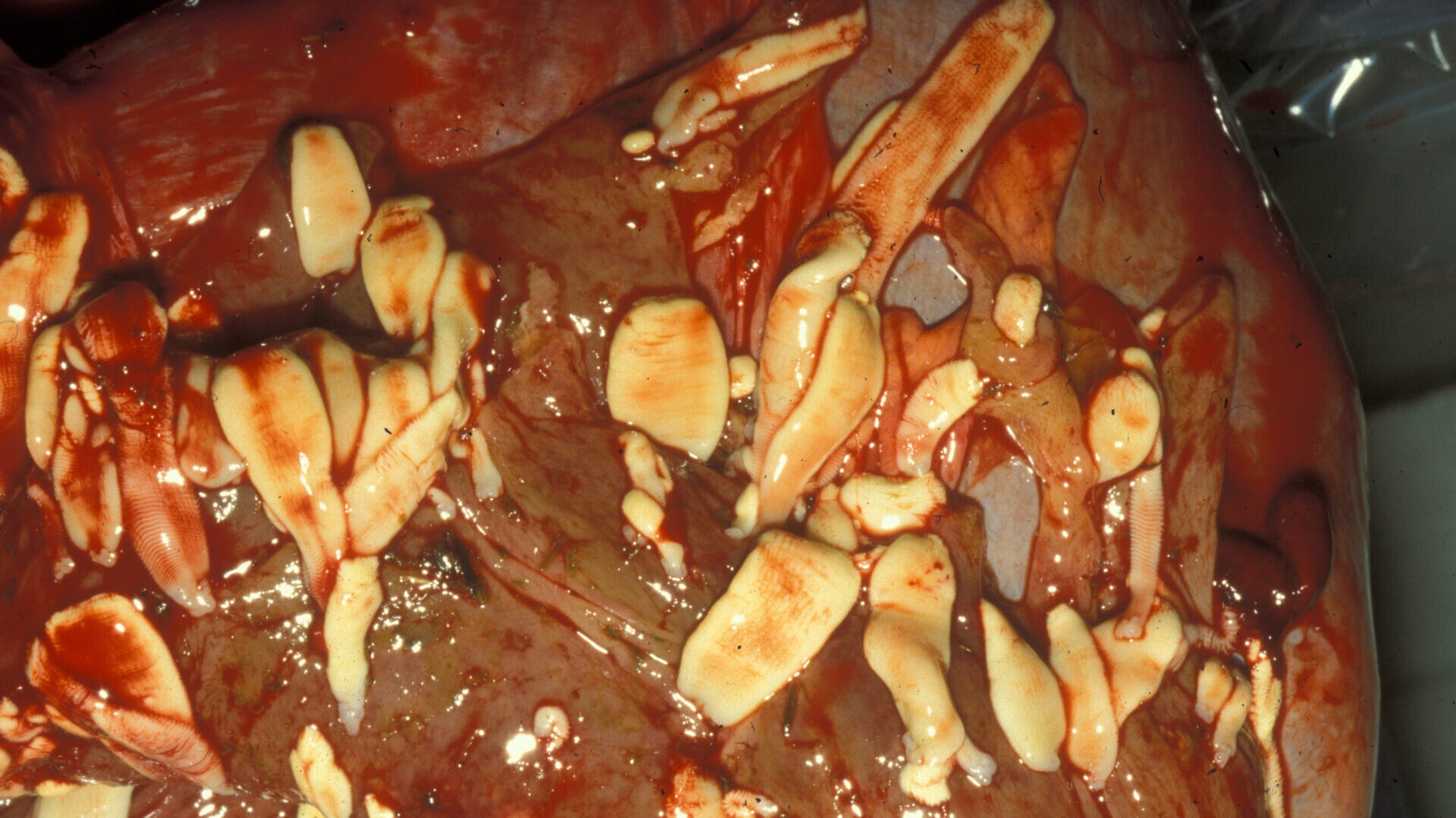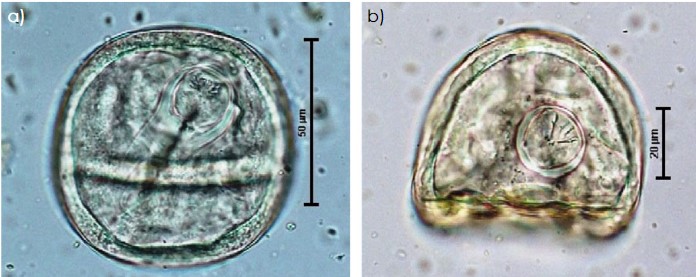The principal tapeworm (cestode) of the horse is Anoplocephala perfoliata. There are two other species of tapeworm that infect horses, Anoplocephala mamillana and Anoplocephala magna, although both are rare in domesticated animals. A. perfoliata is found in most areas of the planet where horses graze, but are uncommon or absent in horses living in dry, arid climates.
Life cycle overview
The tapeworm has an indirect life cycle that involves the oribatid mite as the intermediate host. Oribatid mites consume tapeworm eggs from faeces and pasture. These mites are actually tiny arachnids (spiders). There are many mite species, but only approximately 45 oribatid species are naturally capable of carrying cysticercoids, a larval stage of the tapeworm. This is partly determined by their size, their ability to consume tapeworm eggs, and their ability to move upward from soil to grasses, where they are consumed through grazing. Mites of the Galumna, Scheloribates, and Zygoribatula species are the most commonly infected with tapeworm larvae. They are small, usually less than 1mm. The mites are important for turnover of organic matter in soil, improving soil quality and providing soil enrichment. The numbers of tapeworms appears to be closely related to oribatid mite numbers. Newly seeded and young pastures have low numbers of mites, compared to older pastures that have been undisturbed for two of more years. It is recommended that cultivating pastures annually would reduce mite numbers.

Once the eggs are consumed by the oribatid mite it takes between 8 and 20 weeks to form an infective cysticercoid (a tapeworm larval form). This time is dependent on environmental conditions. The cysticercoid has a scolex (the head of developing tapeworm) with four suckers. After consumption of infective mites by grazing horses the mites are digested leaving the free tapeworm cysticercoid intact. Dependent on the species the preferred sites of attachment are the small intestine (for A. magna and A. mamillana) or the caecum, at or just inside the ileocaecal junction (A. perfoliata).
As the tapeworms mature to become adults (1-8 cm in length and 1-2 cm in width) they form tapeworm segments called proglottids. These segments are released into the intestinal lumen, where on maturation they fill with tapeworm eggs. The proglottids rupture within the intestinal lumen and release the eggs, which are passed in the manure.
The prepatent period from ingestion of an infective mite to release of eggs is 6 to 16 weeks. Interestingly, the lifespan of the adult tapeworm is highly variable, estimated from a few months to several years.
Based on work from Spain, the seasonal prevalence of infection by A. perfoliata was significantly higher in autumn and winter than in spring and summer. They suggested that in their conditions winter was the peak time for eggs to be available for consumption by oribatid mites. A study in Germany reported greatest shedding in late summer through Autumn. The current recommendation is to direct deworming strategies for this parasite in mid-Autumn.
Signs of infection
Most horses surveyed have no or few adult worms, consequently in the vast majority of horses tapeworms have no to minimal impact on health. There is however a strong association between heavy infestations and ileocaecal intussusception. The most distal portion of the small intestine, the ileum, telescopes into the caecum. This is thought to be due to altered patterns of motility induced by the attachment of tapeworms in this region. The telescoped segment swells causing an obstruction of the small intestine. This is a serious condition that requires surgery for correction. Interestingly, since the widespread use of praziquantel the incidence of ileocaecal intussusception has reduced, particularly in New Zealand where the condition was common.


Diagnosis
Proglottids or whole adult worms are rarely seen in manure. The classical method of identification is through detection of eggs in a faecal sample (see below). The classical appearance is a D-shaped egg, with an outer vitelline membrane and a thick, dark inner shell. The eggs are colourless, but have an amber cast when viewed on faecal flotation, caused by contact with intestinal contents. Unfortunately, standard egg detection methods, such the McMaster technique (4 grams of faeces), have a poor sensitivity (<10%) in detecting Anoplocephala eggs. If eggs are seen using this technique then it is likely a large worm burden is present. It has been suggested that the Wisconsin method (using 5 grams of faeces) has a sensitivity of 62% in detecting eggs.
There are modified techniques described that substantially improve the recovery of eggs. These involve using a greater amount of manure (40 grams) and centrifugation to concentrate and then float the eggs. This improves the sensitivity to 61%, and more than 90% for detecting moderate – large infestations, described as more than 20 adult worms.

To increase the diagnostic value performing faecal egg counts 24 hours after deworming with praziquantel confirm and loosely classify the number of parasites.
There has been a lot of recent attention given to serum or saliva-based ELISA tests to detect antibodies to tapeworms. There is a commercially available saliva test available in the UK. They appear to be more useful as a herd overview for parasitism, rather than being useful for individual animals. Horses can remain seropositive for months after treatment. These tests may be useful in semi-arid or arid regions where tapeworm infections may not occur.
Treatment
The treatment of choice is praziquantel (1mg/kg). Other therapies include pyrantel embonate (38 mg/kg) or pyrantel pamoate (13.2 mg/kg). Morantel tartrate (7.5 – 14.0 mg/kg) is labelled for use against Anoplocephala in Australia although data are lacking. A dose of 6 mg/kg cleared only 25% of tapeworms in a small study in 1984. It may be that any effect is similar to the related chemical, pyrantel pamoate, where double the labelled nematode dose is used (13.2 mg/kg). Macrocyclic lactones (ivermectin, abamectin, moxidectin) are not effective against Anoplocephala perfoliata.
There are no data to indicate that treatment more frequently than once a year confers any greater benefit. Over treatment always runs the risk of resistance.
Resistance
Of great concern was the recent report of developing praziquantel and pyrantel resistance in horses. This follows reports of developing resistance of the common tapeworm of dogs and cats (Dipylidium caninum) to praziquantel. This cestode can also infect humans.There has long been concern about praziquantel resistance in Schistosoma mansoni infection in humans. Schistosomiasis is a huge problem in the developing world and praziquantel is the treatment of choice.
Unfortunately in Australia there are many combination products that include praziquantel. The problem of over-medication is an emerging problem and owners are encouraged to source a praziquantel combination product only once yearly.
Tags: Parasites; Gastrointestinal diseases
